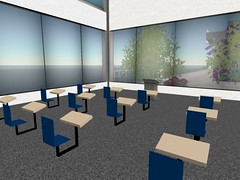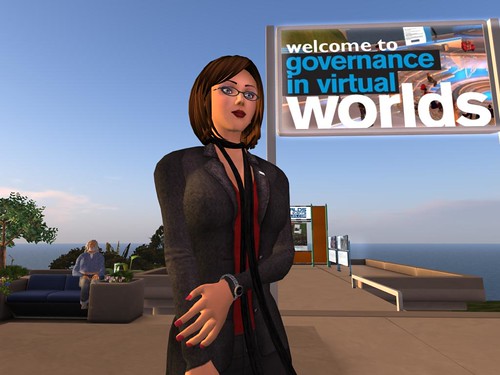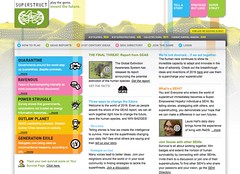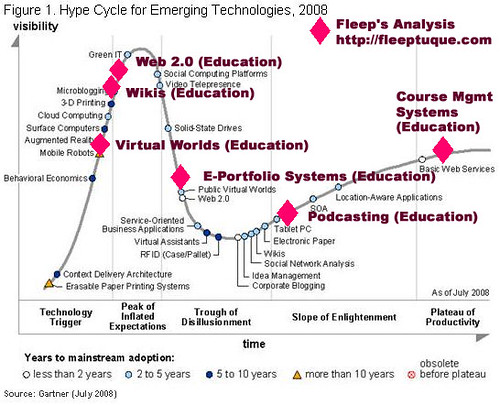This is one of those self-indulgent, reflecting on my own blogging posts, so if you hate that sort of thing, stop reading now.
Wherein the Optimist Wins the Internal (Eternal?) Debate:Â To Blog or Not To Blog
A friend and I recently got into a heated debate about blogging. The context isn’t important so much, but it made me reflect a bit about my own blogging.  (Though I do wonder if I am alone in thinking that sites like Slashdot and the DrudgeReport – no matter how they may have started – are not “blogs”. They are or have become news sites, and news sites are not the same thing as blogs, in my mind.)
What is a blog anyway?
First, I had to separate out what _I_ do that I consider to be blogging. Is Twitter a blog? People say it’s a “micro-blog” but it rarely feels that way to me. It feels more like a group IM conversation with an archive instead of a reflective piece of writing. I think my core definition of blog includes that – a reflective piece of writing is a main feature of the vast majority of blogs. It may reference other sites, it may incorporate different kinds of media, but the essence of the “web log” is a person logging their thoughts, experiences, results, art, images, whatever documentation that can be submitted to the “web log” system, so that others can learn and share from our experiences, so we can learn from the experiences of others, and so we can contribute some part of ourselves to .. well, the world – the world wide web log system, the internet, the metaverse – whatever you want to call it.
This is my blog. This is where, when I can, from time to time, I try to share something of interest to the world. Whoever’s listening, whoever’s reading, whoever shares a passion for the same things I do – here’s the stuff I’m working on. I’m trying to “web log” my work, parts of my life, parts of my family, parts of me. I don’t get as much time to do it as I wish I could, I’m not nearly as skilled at all the different forms of media as I wish I were, and I often self-consciously worry terribly about what people will _think_ of what I say or what I do – but I want to try to share my stuff with people who might care, and I want to have a web log for myself, so I can go back and reflect on what I’ve said, reflect on how my views have changed, or remember why it was that I chose some path that didn’t work out at all like I intended.
A “blog” to me is personal. This blog is personal.
And in this age of .. such rapid change, with all notions of privacy being challenged, of a time in my life when I wear so many hats I couldn’t print a business card that would fit, when my work (which I personally define as attempting to study and help provide answers to the questions: What’s happening on the internet and particularly in that part of the internet they call “virtual worlds”? What implications does it have for education and for society as a whole? What or which of these tools are most effective for teaching, learning, sharing ideas, and instigating positive change?) is studying a rapidly, constantly dynamic phenomenon that I can only study by doing and being involved in to understand the technology well enough to study it.. What part of my life or my work is personal?
Isn’t ALL of it personal?
Is that a stupid question?
Why teachers, professors, and educators should blog
I try in my workshops to talk about how a technology can be used, for teaching, for personal discovery and learning, for organizing distributed workforces or volunteers, for communicating with constituents – but essentially, I don’t know if any of it makes sense until you’ve done it yourself – for yourself. It’s hard to understand the real power of a “web log” until you’ve done it and seen how much it improves your own learning.
For every instructor or faculty member who has asked the question – why would _I_ want to blog? That would be my answer.  We talk about experiential learning, and reflective writing, and all the appropriate buzzwords, but in terms of a tool that really truly enhances and promotes experiential, self-reflective learning, I almost can’t think of a better tool than a blog. Telling a story, to yourself or someone else, and creating or finding the media, creating the narrative, and sending it .. out there, into the big world of all the people in the world having a conversation or sharing in the big web log system, is, frankly, a thrilling experience. Or it can be, it should be. The ability to create something, share something, document some part of your experience, communicate with others who share your passions, create an archive for yourself to learn from too – it’s journaling in the 21st century. All of the great forebears of science, philosophy, and human knowledge recorded their experiences, publishing research is the heart of academia, and the web simply provides a better way to do it.
The “blog” – no matter how far they stretch the term in the media – is a reflective piece of writing that exists for its own sake or ties together all of the elements of an “entry” that is thrust into the global web log system of human knowledge. When you put it out there, you’re talking to everyone, anyone. You’re talking to the person who is reading it now, and the person who will read it tomorrow, and all the people who will read it in the future to come.
What do you have to share with the world of now and the world of tomorrow? What do your students have to share?
Education, at its core, is about training people to think rigorously. It is about teaching people how to distinguish between signal and noise, correlate data, understand cause and effect, think broadly about the implications of our choices, and contribute something meaningful to society as a result of this training.
Speaking with your Digital Voice
To me, this is the beauty of blogging, of twittering, of connecting.. Watching the “web log” and learning from it, seeing my experiences echoed in it, recognizing and appreciating the art in it, applying what I take from it (to my own life and to my work), these things make blogging and participating in the conversation worth the investment of time. The reward, the return, is enormous. The power of finding the information I need or want when I need or want it, of finding the people I need or want when I need or want to talk to them, running across information I didn’t even know I needed – this stuff has changed how I work, how effective I can be, how many people I can reach, teach, learn from – it allows me to be my own teacher, my own guide, and still find the wisdom and the guidance from others whenever I am receptive and ready to learn from them.
Podcasting, videos, virtual worlds, blogging, twitter, social networks, social media, wikis, YouTube, they’re all elements of the same thing – using your digital voice to speak. It is simply another mode of human communication, one with many implications for changing society in the future, and every student, and every teacher, should learn to speak with their digital voice. When you do, the results of what you share are better indexed, searched, and located, which allows others to find you and you to find each other so that between you – between us – we can do a better job of.. whatever it is we want to do (or need to do).
Using our Digital Voice to Solve Real (Big) Problems
The people of the world seem to agree – global warming is real. The people of the world seem to agree – solving the energy crisis is one of the great challenges of our time. The people of the world seem to agree – giving every child an opportunity to live, grow, and learn in safety is a priority. The people of the world seem to agree – actually on quite a number of things. And what we disagree about, what we argue and debate about, the choices we make in our real lives as a result of our experience or nature or knowledge – the web log system is one way we are working it out and looking for answers, looking for solutions, or maybe just the right questions.
Everyone I know these days is saying and thinking, “There has to be a better way of doing things. The world seems like a mess.”  We, as a people, have unprecedented power to reach each other, learn from each other, and work together using our digital voices. Why aren’t we using it to solve the big problems ourselves? Why does it seem everyone is waiting for Them to come up with the answers? Institutions, governments, NGOs, charities, your boss, the board, the People In Charge.
I’ll ask again – why aren’t we solving the big problems ourselves?
I think I’ve come to the conclusion that not enough people with not enough of the right skills know how. I don’t know how, myself, I’m trying to learn. I’m trying to understand how my own actions help or diminish my own cause(s), I’m trying to understand how best to leverage my time and my resources to help solve common problems – or is that ridiculously naive?
A Bad Addiction or Addicted to Empowerment?
Maybe I’m just addicted to the fire-hose, watching the next generation’s version of the boob tube on endless repeat except there’s no repeat – just a steady stream of fresh data, fresh experiences, fresh laughter, fresh music, fresh conversation, fresh opportunities, fresh challenges.. all of the stimulation, freedom, creativity, joy, efficacy, acceptance, and .. empowerment.. that I feel quite denied in the “real world”.
I can’t afford to drive all over and pay for concerts. I don’t have the right credentials to help plan cities or communities or spaces in the real world. I don’t have the right wardrobe to attend certain kinds of functions. I don’t have the capacity to hop-skip around the world to meet a colleague for coffee and chat when I have time. But I can do all of these things online. I can practice at any number of things that relate to people, to creating, to planning, to experimenting.. with virtual things instead of physical things. Virtual resources are, electricity permitting, infinite. Time is not. Talent is not. But if I need to get people together to help me solve a problem, or create a community, if we collectively are going to solve the really big challenges of our time, I’m more convinced than ever that we’ll need our digital voices to do it.
That’s my optimistic answer for why you should blog, why I should blog, why my mom should blog, why teachers should blog. I dunno if that’s right though. The pessimist wins some days.


 irtual worlds, and not enough time thinking about how the rules of virtual worlds would be horrific if implemented in RL. Good point! From my quickly jotted notes as he was speaking:
irtual worlds, and not enough time thinking about how the rules of virtual worlds would be horrific if implemented in RL. Good point! From my quickly jotted notes as he was speaking:
![Reblog this post [with Zemanta]](http://img.zemanta.com/reblog_c.png?x-id=87d05662-8f59-453f-8396-693553b47120)


![Reblog this post [with Zemanta]](http://img.zemanta.com/reblog_c.png?x-id=f831edc0-881a-44cb-b491-b43107ea47bf)

![Reblog this post [with Zemanta]](http://img.zemanta.com/reblog_c.png?x-id=95bddbe6-dd0d-43fa-8a64-c14576474127)



![Reblog this post [with Zemanta]](http://img.zemanta.com/reblog_c.png?x-id=747e33a2-bd05-4448-b789-a033ad76f097)
